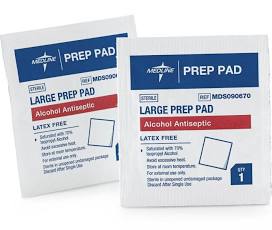You are quietly typing away at your computer when the familiar (but not entirely pleasant) sound of retching fills the air. You look out onto the side and see a young woman dry-heaving into a pink plastic bucket, looking miserable. This person will obviously need anti-emetics, but you know that 30+ minutes may pass before she has a line to administer them.
Is there anything we can do meanwhile to help relieve patient’s symptoms?
Lurking in the Anesthesia literature is the curious finding that nasally inhaled Isopropyl Alcohol often outperforms Zofran and Promethazine in its anti-emetic effect, and does so in a much faster time. But where could we possibly find a steady supply of Isopropyl Alcohol in the ED? Surely we don’t have a bottle in the Pyxis…maybe run to the nearest bar?
Ah yes, the lowly Alcohol prep-pad. Much used and often unheralded, this little guy contains 70% Isopropyl Alcohol, costs mere pennies, and has a convenient packaging, ready for the patient to start sniffing.
And while anesthesia literature is appropriate for post-operative patients, can these findings carry over to the ED?
Beadle et al. performed the first randomized, placebo controlled, double-blinded study on ED patients who presented with a chief complaint of nausea and/or vomiting. They compared Isopropyl Alcohol inhalation to the inhalation of Normal Saline, and utilized an 11-point verbal numeric response scale score for nausea, as well as patient satisfaction. 37 patients were assigned to the alcohol group, while 43 were in the saline group.
The study showed that after only 10 minutes, the “median nausea verbal numeric response scale score was 3 in the isopropyl alcohol arm vs. 6 in the placebo arm, for an effect size of 3 (95% CI 2 to 4)…[and then] median satisfaction score was 4 in the isopropyl alcohol arm versus 2 in the placebo arm, for an effect size of 2 (95% CI 2 to 2).”
In other words, nausea went down, while patient satisfaction went up.
A simple method of administration would be to tear open an Isopropyl Alcohol prep pad, keep it in the wrapper, and instruct the patient to keep it close to his/her nose, inhaling through the nose and out through the mouth. A new pad can be opened when the intensity of the smell starts to diminish, signifying evaporation of the alcohol. This can be done while preparations are made to draw labs and place a line.
Conclusion: If this study’s results can be recreated, this extremely simple, readily available modality to treat nausea in the very short-term can be an effective bridge to longer lasting anti-emetics during the patient’s hospital stay. Also, given how important patient satisfaction is to hospital metrics, this can make the nauseated patients, his/her neighbors, and the provider happy by minimizing the sonic assault that occurs while someone attempts to bring up their gastric contents in a busy ED hallway.
References: Beadle KL, Helbling AR, Love SL, April MD, Hunter CJ. Isopropyl Alcohol Nasal Inhalation for Nausea in the Emergency Department: A Randomized Controlled Trial. Ann Emerg Med. 2015; doi: http://dx.doi.org/10.1016/j.annemergmed.2015.09.031.
Cotton J, Rowell L, Hood R, Pellegrini J. A comparative analysis of isopropyl alcohol and ondansetron in the treatment of postoperative nausea and vomiting from the hospital setting to the home. AANA J. 2007;75(1):21-26. [PubMed]

